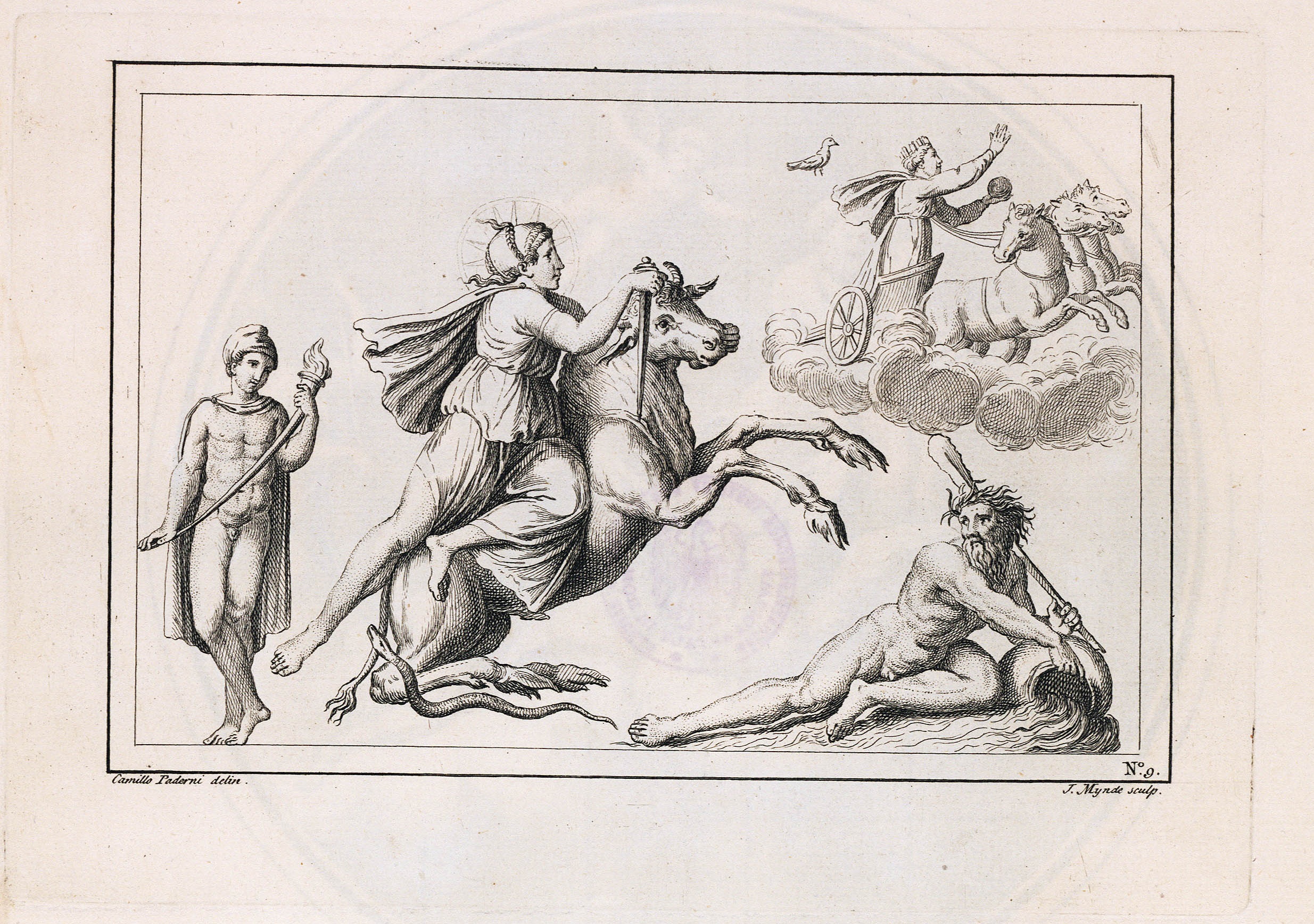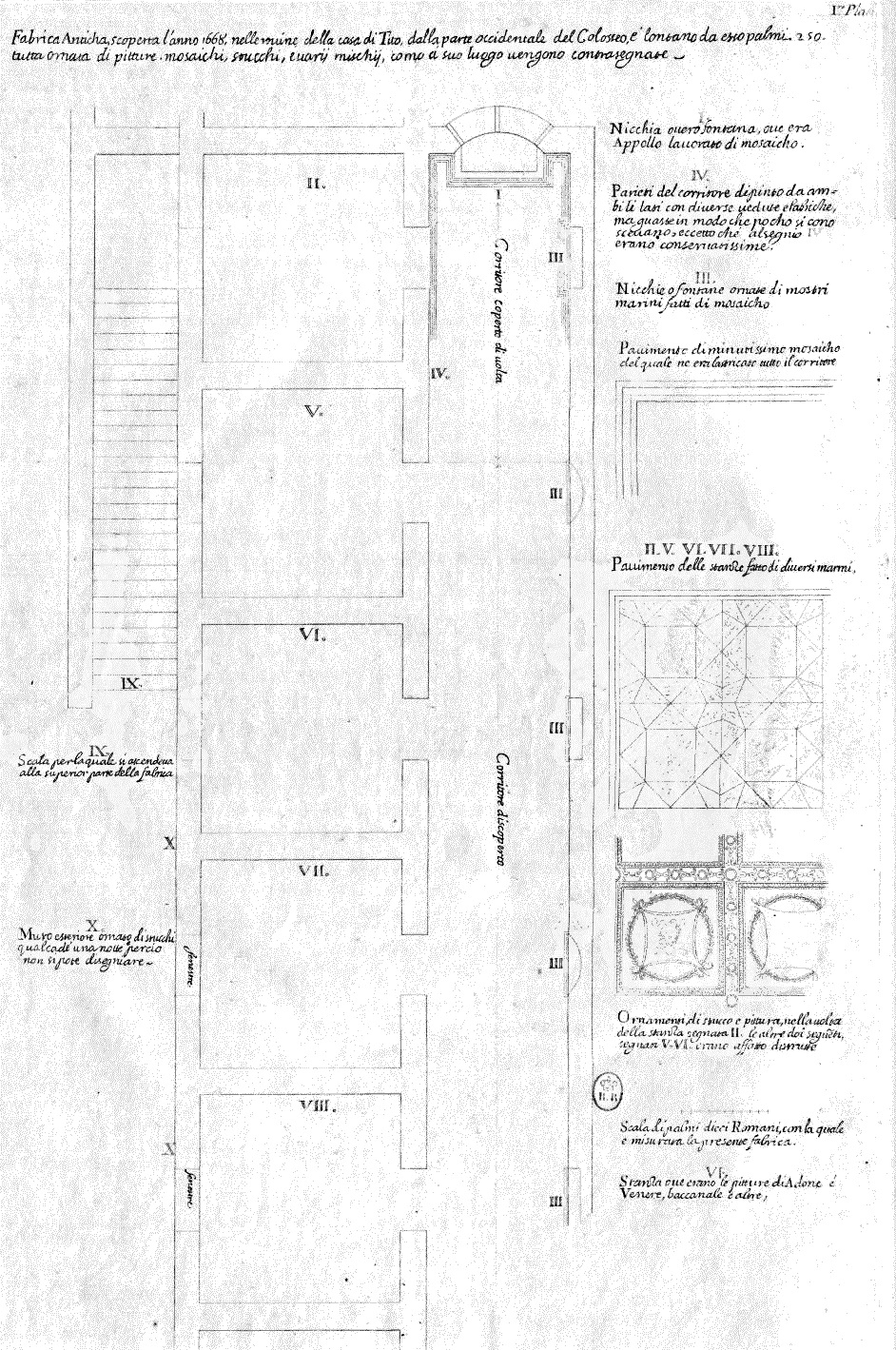
CIMRM 337 - Fresco of tauroctony. Rome. Now lost.


There seems to have been a Mithraeum in a large house in the since-destroyed Baths of Titus2, facing the Colosseum. Various pictures and mosaics were found in the house in July 1668, and painted by Pietro Sante Bartoli. Our fresco is recorded in various later copies.
Eton college have kindly supplied me with a copy of their watercolour for offline use only. The colours in this are as follows: white paper, thick red border, within which narrow white border, within which black rectange. Sky is blue, ground is greenish-brown. Cautes is naked, wearing a red cloak and a yellow Phrygian hat. The flame of the torch is red. Mithras is dressed in yellow, with a yellow hat and a red cloak. Normal flesh tones. The bull is grey, the blood from the dagger is red. The snake is grey also. The raven and the cloud it stands on are grey. Sol is dressed in red, with a blue belt and a yellow cloak and crown. The orb he carries in her left hand is blue. The chariot is yellow; the horses are brownish, the cloud is grey. The reclining figure is naked, with a green wreath around his head, and carrying a club which is light brown, and leaning on a vase which is also light brown and open toward the viewer.
CIMRM entry
337 Wall-painting, discovered in the Casa di Tito "22 genare 1668 vicine il Colosseo" (Holk., II, 36).
In the beginning of the 18th century Topham made a number of aquarels, which were afterwards collected in five volumes and presented by him to Eton College. One of them represents our fresco (Eton, II No. 19). Another reproduction slightly deviating, however, (the reclining figure has been left out and the raven flies over Mithras' head) is given by Codex Nettuno, f. 156 (cf. Windsor Castle Library, vol. 175 No. 11405). Finally two volumes with paintings are preserved at Holkham Hall, which also contains the painting discussed here (Holk., II, 36). Turnbull, Painting, Pl. 9; Lanciani in BCR 1895, 178f; Ashby in PapBrSR VII, 1911, 19 No. 19; RM XI, 218; RRP 29, 1; MM, 230. See fig. 94.
In the centre Mithras in diadem, radiate crown and nimbus is slaying the bull, represented as a sea-animal, whereas the god himself has the appearance of Europa. The bull is sitting on his hind-legs and his fore-legs are lifted. The serpent is creeping to the left. Behind the scene stand Cautes, cross-legged, dressed in a long cloak only and in a Phrygian cap. On the other side a naked figure in long hair and beard lies on the ground. In his left hand he holds an oar over his shoulder and with his r.h. he empties a vessel of water (Oceanus). In the clouds over his head Sol is seen, with radiate crown on his head, in a quadriga. He raises both hands and holds a globe in his l.h. A little black bird (raven?) behind him.
The Eton manuscript.
The collection of watercolours by Richard Topham arrived at the Eton College library in 1736. The Eton college OPAC has the following details of their item: Height (actual size): 264mm; width (actual size): 356mm; Ashby gives the dimensions as 169 x 259 but the actual drawing on the page measures 188mm x 278mm. del Palazzo di Tito written in ink on the back of the drawing. Watercolour on paper. Artist: Bartoli, Francesco (1675? - 1730?). Made: c.1710-1730.
Pietro Santi Bartoli.
A volume of paintings by Pietro Santi Bartoli exists: Recueil de peintures antiques trouvées à Rome, 2 vols, 1783. (In full: Recueil de peintures antiques trouvées à Rome; imitées fidélement, pour les couleurs et le trait, d'après les dessins coloriés par Pietro-Sante Bartoli, et autres dessinateurs. [Descriptive text by P.J. Mariette, edited by comte de Caylus]). An example of a plate from this is given NYPL Digital Library, Record ID: 1063363: "Pittura anticha, trovata l'anno 1668, nella casa di Tito / Antique painting, found in 1668, in the house of Tito" (sic).
A copy of the volume in monochrome is at Gallica. On p.13 is a map of a "fabrica anticha, scoperte l'anno 1668 nelle ruine della casa di Tito, dalla parte occidentale del Colosseo, e longano da esso palmi 250, tutta ornaia di pittura...". On the next page is the French text for the figure:
337 Plan d'un édifice qui faisoit partie des Thermes de Titus, et dont on fit la découverte au mois de Juillet de l'année 1068, dans la partie de ces Thermes qui regarde le Colisée, et à la distance de 250 palmes romains de ce dernier monument. Ce bâtiment, qu'on estime être un ouvrage de Trajan ou d'Adrien, consistoit en plusieurs chambres (Nos. II. V. VI. VII. et VIII.) étant à la suite l'une de l'autre sans aucune communication, et toutes égales en grandeur, c'est-à-dire, de 23 palmes ou 16 pieds en tout sens. Leur ancien pavé subsistoit encore; c'étoit un assemblage de carreaux de marbre de diverses couleurs, formant un compartiment régulier dont on a un échantillon sur un des côtés du plan, avec un pareil échantillon des ornements mêlés de stuc et de peinture qui tapissoient la voûte de la chambre du fond (No. II.) cette voûte étoit la seule qui fût demeurée entiere; celles de toutes les autres chambres et de la plus grande partie du corridor voisin étoient tombées de vétusté.
There is no mention of Mithras, however.
| 1 | Correspondence with Eton College, 6th Jan. 2015. |
| 2 | Samuel Ball Platner, Thermae Titi, A Topographical Dictionary of Ancient Rome, London 1929: "In the same century Palladio made a plan of the ruins then existing (Devonshire coll. portf. v.; BC 1895, 110‑113). These ruins were afterwards almost entirely destroyed, although some meagre remains have recently been found (BC 1895, 113‑115; cf. LS III.248)... The thermae were situated just west of the later thermae Traianae on the edge of the slope overhanging the Colosseum, with the same orientation as the domus Aurea, and occupied a nearly rectangular area, about 105 by 120 metres. The façade and principal entrance were on the north side. On the south side a wide flight of steps led down to the paved area around the Colosseum, 18 metres below, where there are traces of a porticus which may have belonged to the approach to the thermae or have surrounded a large part of the Colosseum area (BC 1895, 118‑121; NS 1895, 201, 226)." |
| Tweet |